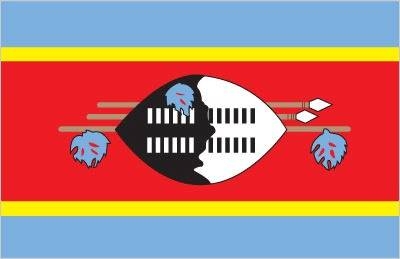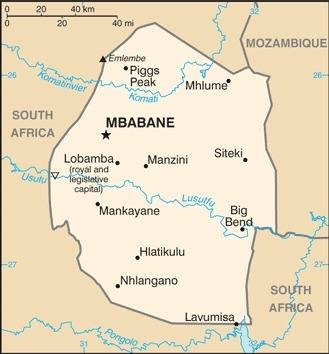195 Eswatini

Three horizontal bands of blue (top), red (triple width), and blue. The red band is edged in yellow. Centered in the red band is a large black and white shield covering two spears and a staff decorated with feather tassels, all placed horizontally. Blue stands for peace and stability, red represents past struggles, and yellow the mineral resources of the country. The shield, spears, and staff symbolize protection from the country’s enemies, while the black and white of the shield are meant to portray black and white people living in peaceful coexistence.
Flag courtesy of the CIA World Factbook

Map courtesy of the CIA World Factbook

A 19th-century Swazi container, carved in wood
Government
According to Britannica, executive authority is vested in the king and is exercised through a dual system of government. The king appoints a prime minister and a cabinet of ministers to advise him on government matters. In addition, there is the Swazi National Council, which advises the king on all matters regulated by Swazi Law and Custom and connected with Swazi traditions and culture. Eswatini’s legislature is bicameral. The House of Assembly comprises 65 members, of whom 55 are elected by popular vote and 10 are appointed by the king. The House of Assembly may sometimes have an additional member if the speaker of the House is chosen from outside that body. The Senate has 30 members, of whom 10 are elected by the House of Assembly and 20 are appointed by the king. The general electorate consists of all citizens over the age of 18 grouped into 55 constituencies (tinkhundla). Each tinkhundla elects one member to the House of Assembly; elections are held at intervals of no more than five years. Political parties are banned, but, nonetheless, several are active in the country.
Eswatini’s judicial system is dualistic, with both constitutional and traditional courts. The constitutional courts comprise the Court of Appeal, the High Court, subordinate or magistrate’s courts, and an industrial court. There are also traditional Swazi National Courts, including two courts of appeal and a higher appeal court. The Swazi National Courts hear only cases in which all those involved are Swazi and the charges fall within a restricted list of criminal and civil matters. They must defer to the constitutional courts in any case of conflict between the two systems.
Local government is administered on a regional level. An administrator appointed by the king heads each of the country’s four regions (Hhohho, Lubombo, Manzini, and Shiselweni).
Eswatini Civil Aviation Authority (ESWACAA)
The Eswatini Civil Aviation Authority (ESWACAA) is a statutory body that was established by the Government of the Kingdom of Eswatini through an Act of Parliament, the Civil Aviation Authority Act No.10 of 2009, and became operational on 7 December 2009. The Civil Aviation Authority is an administrative and commercial body corporate mandated to provide, in an economically viable manner, air transport services and regulation of civil aviation activities in Eswatini; in accordance with international standards. As civil aviation is a very technical and heavily regulated global industry, it became necessary to establish an autonomous body that would focus on the growth and professional management of the industry and have the Ministry of Public Works and Transport as its oversight. The Authority manages King Mswati III International Airport, Matsapha Airport and the Nhlangano Airstrip.
Airspace
SkyVector – Google Maps – ADS-B Exchange
ICAO countries publish an Aeronautical Information Publication (AIP). This document is divided into three parts: General (GEN), En Route (ENR) and Aerodromes (AD). ENR 1.4 details the types of airspace classes they chose to adopt from classes A through G.
Drone Regulations
Advanced Air Mobility (AAM) Regulations & Policies
None found by the author.
However, should you, the reader, happen to stumble across something to the contrary, please email the author at FISHE5CA@erau.edu and you may be mentioned in the ACKNOWLEDGEMENTS section of this book by way of thanks for contributing to this free eBook!
Advanced Air Mobility (AAM) News
2025
Video courtesy of Advanced Air Mobility Institute from the July 2025 Global AAM Forum.
Short Essay Questions
Scenario-Based Question
You have been hired by a Drone Startup Company. Your boss has immediately assigned this job to you.
They need you to prepare a one-page memo detailing the legalities of using a drone to film King Sobhuza 2 Memorial Park in Eswatini.
They need you to mention any national laws and local ordinances.
They specifically want to know what airspace (insert pictures) you will be operating in and whether or not you need an airspace authorization.
Does it matter whether or not you are a citizen of the country?
Lastly, there is a bonus for you if, as you scroll through this chapter, you find any typos or broken links!
Short Essay Questions
- What are the drone categories?
- How is registration addressed?
- How is remote ID addressed?
- What are the model aircraft rules?
- What are the commercial drone rules?
- Are there waivers or exemptions to the rules? If so, for what?
- Would you share a link to an interactive airspace map?
- How is BVLOS addressed?
- How can you fly drones at night?
- How can you fly drones over people?
- Where do you find drone NOTAMs?
- What are the rules for drone maintenance?
- What are the rules for an SMS program?
- What are some unique rules not mentioned above?
- What are the C-UAS rules?
- What are the AAM rules?

